The Ionospheric Responses from Satellite Observations within Middle Latitudes to the Strong Magnetic Storm on 25–26 August 2018
Abstract
1. Introduction
2. Background Information
3. Data Analysis
3.1. The Electromagnetic Disturbances on CSES Satellite
3.2. The Perturbations in Electron Density and Temperature from CSES
4. Discussion on the Corresponding Processes in Ionosphere
4.1. The Comparison of Plasma Parameters at Different Altitudes
4.2. The Movement of Midlatitude Trough during the Magnetic Storm
5. Conclusions
- (1)
- Typical penetration signals of electric field were illustrated during three storm phases from the ultra-low frequency band to very low frequency band in either local daytime or nighttime from CSES. Ne showed strong correlation with electric fields in extremely low frequency bands under 1125 Hz in local daytime at 0–30° N and 15–45° S in the nightside during the main phase, while in the recovery phase, the high positive correlation between electric fields and Ne were concentrated at 0–15° S, 45–60° S in the dayside, and in the nightside 30–45° Swhere the penetration of electric fields and enhanced Ne were concentrated at. The interaction of electric fields with ionospheric electron density decreased in the nightside both at the main phase or recovery phase, compared to in the dayside.
- (2)
- High solar speed generated significant effects during the recovery phase, especially the nighttime ionosphere, with lower Ne in 27–28 August at low latitudes. Higher negative correlation occurred with r < −0.5 of speed/TEC in the nightside during the recovery phase, while solar wind pressure contributed less during the recovery phase with r < 0.4 than those in main phase with r > 0.6.
- (3)
- Multi observations reveal the local time dependence of Ne and TEC to this magnetic storm, with four local time variation modes presented. The depletion of Ne is much clearer at low latitudes in local daytime at a fast recovery time on 26 August, but it is obvious at medium and low latitudes in local nighttime during the slow recovery time of 27–29 August. The electric field observations from CSES in the dayside of 14LT and the nightside of 02LT demonstrated the strong penetration electric at middle and low latitudes in extremely low frequency and very low frequency both in the main phase and recovery phase, but some regions still exist with a correlation r < 0.1, which was also revealed in many small r values of speed and pressure with TEC. The regional ionospheric response needs to consider the local plasma and neutral particle environment, as suggested in other research.
Author Contributions
Funding
Institutional Review Board Statement
Data Availability Statement
Acknowledgments
Conflicts of Interest
References
- Grigorenko, E.I.; Lysenko, V.N.; Taran, V.I.; Chernogor, L.F. Results of Radar Studies of Processes in the Ionosphere that Accompanied the Strongest Geomagnetic Storm of September 25, 1998. Usp. Sovrem. Radioelektron. 2003, 9, 57–94. [Google Scholar]
- Grigorenko, E.I.; Lysenko, V.N.; Pazyura, S.A.; Taran, V.I.; Chernogor, L.F. Ionospheric disturbances during the severe magnetic storm of November 7–10, 2004. Geomagn. Aeron. 2007, 47, 720–738. [Google Scholar] [CrossRef]
- Zou, S.; Moldwin, M.B.; Coster, A.; Lyons, L.R.; Nicolls, M.J. GPS TEC observations of dynamics of the mid-latitude trough during substorms. Geophys. Res. Lett. 2011, 38, L14109. [Google Scholar] [CrossRef]
- Polekh, N.; Zolotukhina, N.; Kurkin, V.; Zherebtsov, G.; Shi, J.; Wang, G.; Wang, Z. Dynamics of ionospheric disturbances during the 17–19 March 2015 geomagnetic storm over East Asia. Adv. Space Res. 2017, 60, 2464–2476. [Google Scholar] [CrossRef]
- Brace, L.H.; Chappell, C.R.; Chandler, M.O.; Comfort, R.H.; Horwitz, J.L.; Hoegy, W.R. Fregion electron temperature signatures of the plasmapause based on Dynamics Explorer 1 and 2 measurements. J. Geophys. Res. Space Phys. 1988, 93, 1896–1908. [Google Scholar] [CrossRef]
- Deminov, M.G.; Karpachev, A.T.; Annakuliev, S.K.; Afonin, V.V.; Smilauer, Y. Dynamics of the ionization troughs in the night-time subauroral F-region during geomagnetic storms. Adv. Space Res. 1996, 17, 141–145. [Google Scholar] [CrossRef]
- Echer, E.; Korth, A.; Zong, Q.-G.; Fraünz, M.; Gonzalez, W.D.; Guarnieri, F.L.; Fu, S.Y.; Rème, H. Cluster observations of O+escape in the magnetotail due to shock compression effects during the initial phase of the magnetic storm on 17 August 2001. J. Geophys. Res. 2008, 113, A05209. [Google Scholar] [CrossRef]
- Zeren, Z.; Cao, J.; Liu, W.; Fu, H.; Wang, T.; Zhang, X.; Shen, X. Storm time evolution of ELF/VLF waves observed by DEMETER satellite. J. Geophys. Res. Space Phys. 2014, 119, 2612–2622. [Google Scholar] [CrossRef]
- Píša, D.; Parrot, M.; Santolik, O.; Menietti, J.D. EMIC waves observed by the low-altitude satellite DEMETER during the November 2004 magnetic storm. J. Geophys. Res. Space Phys. 2015, 120, 5455–5464. [Google Scholar] [CrossRef]
- Yang, N.; Le, H.; Liu, L. Statistical analysis of the mid-latitude trough position during different categories of magnetic storms and different storm intensities. Earth Planets Space 2016, 68, 171. [Google Scholar] [CrossRef]
- Bhattarai, N.; Chapagain, N.P.; Adhikari, B. Total Electron Content and Electron Density Profile Observations during Geomagnetic Storms using COSMIC Satellite Data. Discovery 2016, 52, 1979–1990. [Google Scholar]
- Cherniak, I.; Zakharenkova, I.; Sokolovsky, S. Multi-Instrumental Observation of Storm-Induced Ionospheric Plasma Bubbles at Equatorial and Middle Latitudes. J. Geophys. Res. Space Phys. 2019, 124, 1491–1508. [Google Scholar] [CrossRef]
- Wang, Q.; Huang, J.P.; Zhang, X.M.; Shen, X.H.; Yuan, S.G.; Zeng, L.; Cao, J.B. China Seismo-Electromagnetic Satellite search coil magnetometer data and initial results. Earth Planet. Phys. 2018, 2, 462–468. [Google Scholar] [CrossRef]
- Aa, E.; Zhang, S.R.; Wang, W.; Erickson, P.J.; Qian, L.; Eastes, R.; Harding, B.J.; Immel, T.J.; Karan, D.K.; Daniell, R.E.; et al. Pronounced suppression and X-pattern merging of equatorial ionization anomalies after the 2022 Tonga volcano eruption. J. Geophys. Res. Space Phys. 2022, 127, e2022JA030527. [Google Scholar] [CrossRef] [PubMed]
- Cai, X.; Burns, A.G.; Wang, W.; Qian, L.; Solomon, S.C.; Eastes, R.W.; McClintock, W.E.; Laskar, F.I. Investigation of a Neutral “Tongue” Observed by GOLD During the Geomagnetic Storm on May 11, 2019. J. Geophys. Res. Space Phys. 2021, 126, e2020JA028817. [Google Scholar] [CrossRef]
- Balan, N.; Liu, J.Y.; Otsuka, Y.; Ram, S.T.; Luhr, H. Ionospheric and thermospheric storms at equatorial latitudes observed by CHAMP, ROCSAT, and DMSP. J. Geophys. Res. 2012, 117, A01313. [Google Scholar] [CrossRef]
- Tulasi Ram, S.; Balan, N.; Veenadhari, B.; Gurubaran, S.; Ravindran, S.; Tsugawa, T.; Liu, H.; Niranjan, K.; Nagatsuma, T. First observational evidence for opposite zonal electric fields in equatorial E and F region altitudes during a geomagnetic storm period. J. Geophys. Res. 2012, 117, A09318. [Google Scholar] [CrossRef]
- Kelley, M.C.; Vlasov, M.N.; Foster, J.C.; Coster, A.J. A quantitative explanation for the phenomenon known as storm-enhanced density. Geophys. Res. Lett. 2004, 31, L19809. [Google Scholar] [CrossRef]
- Vlasov, M.; Kelley, M.C.; Kil, H. Analysis of ground-based and satellite observations of F-region behavior during the great magnetic storm of July 15, 2000. J. Atmos. Sol.-Terr. Phys. 2003, 65, 1223–1234. [Google Scholar] [CrossRef]
- Blagoveshchensky, D.V.; Sergeeva, M.A. Ionospheric parameters in the European sector during the magnetic storm of August 25–26, 2018. Adv. Space Res. 2020, 65, 11–18. [Google Scholar] [CrossRef]
- Mansilla, G.A.; Zossi, M.M. Ionospheric response to the 26 August 2018 geomagnetic storm along 280° E and 316° E in the South American sector. Adv. Space Res. 2022, 69, 48–58. [Google Scholar] [CrossRef]
- Bolaji, O.S.; Fashae, J.B.; Adebiyi, S.J.; Owolabi, C.; Adebesin, B.O.; Kaka, R.O.; Ibanga, J.; Abass, M.; Akinola, O.O.; Adekoya, B.J.; et al. Storm time effects on latitudinal distribution of ionospheric TEC in the American and Asian-Australian sectors: August 25–26, 2018 geomagnetic storm. J. Geophys. Res. Space Phys. 2021, 126, e2020JA029068. [Google Scholar] [CrossRef]
- Piersanti, M.; De Michelis, P.; Del Moro, D.; Tozzi, R.; Pezzopane, M.; Consolini, G.; Marcucci, M.F.; Laurenza, M.; Di Matteo, S.; Pignalberi, A.; et al. From the sun to the earth: August 25, 2018 geomagnetic storm effects. Ann. Geophys. 2020, 38, 703–724. [Google Scholar] [CrossRef]
- Astafyeva, E.; Yasyukevich, Y.V.; Maletckii, B.; Oinats, A.; Vesnin, A.; Yasyukevich, A.S.; Syrovatskii, S.; Guendouz, N. Ionospheric disturbances and irregularities during the 25–26 August 2018 geomagnetic storm. J. Geophys. Res. Space Phys. 2022, 127, e2021JA029843. [Google Scholar] [CrossRef]
- Cherniak, I.; Zakharenkova, I. Development of the Storm-Induced Ionospheric Irregularities at Equatorial and Middle Latitudes During the 25–26 August 2018 Geomagnetic Storm. Space Weather 2022, 20, e2021SW002891. [Google Scholar] [CrossRef]
- Shen, X.; Zong, Q.; Zhang, X. Introduction to special section on the China Seismo-Electromagnetic Satellite and initial results. Earth Planet. Phys. 2018, 2, 439–443. [Google Scholar] [CrossRef]
- Shen, X.H.; Zhang, X.; Yuan, S.G.; Wang, L.W.; Cao, J.B.; Huang, J.P.; Zhu, X.H.; Piergiorgio, P.; Dai, J.P. The state-of-the-art of the China Seismo-Electromagnetic Satellite mission. Sci. China Technol. Sci. 2018, 61, 634–642. [Google Scholar] [CrossRef]
- Zhou, B.; Yang, Y.Y.; Zhang, Y.T.; Gou, X.C.; Cheng, B.J.; Wang, J.D.; Li, L. Magnetic field data processing methods of the China Seismo-Electromagnetic Satellite. Earth Planet. Phys. 2018, 2, 455–461. [Google Scholar] [CrossRef]
- Cheng, B.J.; Zhou, B.; Magnes, W.; Lammegger, R.; Pollinger, A. High precision magnetometer for geomagnetic exploration onboard of the China Seismo-Electromagnetic Satellite. Sci. China Technol. Sci. 2018, 61, 659–668. [Google Scholar] [CrossRef]
- Cao, J.B.; Zeng, L.; Zhan, F.; Wang, Z.G.; Wang, Y.; Chen, Y.; Meng, Q.C.; Ji, Z.Q.; Wang, P.F.; Liu, Z.W.; et al. The electromagnetic wave experiment for CSES mission: Search coil magnetometer. Sci. China Technol. Sci. 2018, 61, 653–658. [Google Scholar] [CrossRef]
- Wang, H.; He, Y.F.; Lühr, H.; Kistler, L.M.; Saikin, A.A.; Lund, E.J.; Ma, S.-Y. Storm Time EMIC Waves Observed by Swarm and Van Allen Probe Satellites. J. Geophys. Res. Space Phys. 2019, 124, 293–312. [Google Scholar] [CrossRef]
- Huang, J.P.; Lei, J.G.; Li, S.X.; Zeren, Z.M.; Li, C.; Zhu, X.H.; Yu, W.H. The Electric Field Detector (EFD) onboard the ZH-1 satellite and first observational results. Earth Planet. Phys. 2018, 2, 469–478. [Google Scholar] [CrossRef]
- Yan, R.; Guan, Y.B.; Shen, X.H.; Huang, J.P.; Zhang, X.M.; Liu, C.; Liu, D.P. The Langmuir Probe Onboard CSES: Data inversion analysis method and first results. Earth Planet. Phys. 2018, 2, 479–488. [Google Scholar] [CrossRef]
- Chu, W.; Huang, J.P.; Shen, X.H.; Wang, P.; Li, X.Q.; An, Z.H.; Xu, Y.B.; Liang, X.H. Preliminary results of the High Energetic Particle Package on-board the China Seismo-Electromagnetic Satellite. Earth Planet. Phys. 2018, 2, 489–498. [Google Scholar] [CrossRef]
- Li, X.Q.; Xu, Y.B.; An, Z.H.; Liang, X.H.; Wang, P.; Zhao, X.Y.; Wang, H.Y.; Lu, H.; Ma, Y.Q.; Shen, X.H.; et al. The high-energy particle package onboard CSES. Radiat. Detect. Technol. Methods 2019, 3, 22. [Google Scholar] [CrossRef]
- Ambrosi, G.; Bartocci, S.; Basara, L.; Battiston, R.; Burger, W.J.; Carfora, L.; Castellini, G.; Cipollone, P.; Conti, L.; Contin, A.; et al. The HEPD particle detector of the CSES satellite mission for investigating seismo-associated perturbations of the Van Allen belts. Sci. China Technol. Sci. 2018, 61, 643–652. [Google Scholar] [CrossRef]
- Lin, J.; Shen, X.H.; Hu, L.C.; Wang, L.W.; Zhu, F.Y. CSES GNSS ionospheric inversion technique, validation and error analysis. Sci. China Technol. Sci. 2018, 61, 669–677. [Google Scholar] [CrossRef]
- Cheng, Y.; Lin, J.; Shen, X.H.; Wan, X.; Li, X.X.; Wang, W.J. Analysis of GNSS radio occultation data from satellite ZH-01. Earth Planet. Phys. 2018, 2, 499–504. [Google Scholar] [CrossRef]
- Chen, L.; Ou, M.; Yuan, Y.P.; Sun, F.; Yu, X.; Zhen, W.M. Preliminary observation results of the Coherent Beacon System onboard the China Seismo-Electromagnetic Satellite-1. Earth Planet. Phys. 2018, 2, 505–514. [Google Scholar] [CrossRef]
- Zhang, X.; Qian, J.; Shen, X. Solar cycle variation of the electron density in the topside ionosphere at local nighttime observed by DEMETER during 2006–2008. J. Geophys. Res. Space Phys. 2014, 119, 3803–3814. [Google Scholar] [CrossRef]
- Zhang, X. Electron Density Comparison Between IRI 2007 and DEMETER Satellite Data in Solar Minimum Year. Terr. Atmos. Ocean. Sci. 2014, 25, 559. [Google Scholar] [CrossRef][Green Version]
- Zhang, X.; Shen, X.; Liu, J.; Yao, L.; Yuan, G.; Huang, J. The asymmetrical features in electron density during extreme solar minimum. Adv. Space Res. 2014, 54, 2236–2248. [Google Scholar] [CrossRef]
- Olsen, N.; Friis-Christensen, E.; Floberghagen, R.; Alken, P.; Beggan, C.; Chulliat, A.; Doornbos, E.; da Encarnacao, J.T.; Hamilton, B.; Hulot, G.; et al. The Swarm Satellite Constellation Application and Research Facility (SCARF) and Swarm data products. Earth Planets Space 2013, 65, 1189–1200. [Google Scholar] [CrossRef]
- Schaer, S. Mapping and Predicting the Earth’s Ionosphere Using the Global Positioning System. Ph.D. Thesis, Astronomical Institute University of Bern, Bern, Switzerland, 1999. [Google Scholar]
- Ren, D.; Lei, J.; Zhou, S.; Li, W.; Huang, F.; Luan, X.; Dang, T.; Liu, Y. High-Speed Solar Wind Imprints on the Ionosphere During the Recovery Phase of the August 2018 Geomagnetic Storm. Space Weather 2020, 18, e2020SW002480. [Google Scholar] [CrossRef]
- Akala, A.O.; Oyedokun, O.J.; Amaechi, P.O.; Simi, K.G.; Ogwala, A.; Arowolo, O.A. Solar Origins of August 26, 2018 Geomagnetic Storm: Responses of the Interplanetary Medium and Equatorial/Low-Latitude Ionosphere to the Storm. Space Weather 2021, 19, e2021SW002734. [Google Scholar] [CrossRef]
- Chen, C.Y.; Liu, T.J.Y.; Lee, I.T.; Rothkaehl, H.; Przepiorka, D.; Chang, L.C.; Matyjasiak, B.; Ryu, K.; Oyama, K.-I. The Midlatitude Trough and the Plasmapause in the Nighttime Ionosphere Simultaneously Observed by DEMETER During 2006-2009. J. Geophys. Res. Space Phys. 2018, 123, 5917–5932. [Google Scholar] [CrossRef]
- He, M.; Liu, L.; Wan, W.; Zhao, B. A study on the nighttime midlatitude ionospheric trough. J. Geophys. Res. 2011, 116, A05315. [Google Scholar] [CrossRef]
- Deminov, M.G.; Karpachev, A.T.; Afonin, V.V.; Annakuliev, S.K. Dynamics of the midlatitude ionosphreic trough during storms: Main phase. Geomag. Aeron. 1995, 35, 69–77. [Google Scholar]
- Deminov, M.; Shubin, V.N. Empirical Model of the Location of the Main Ionospheric Trough. Geomagn. Aeron. 2018, 58, 348–355. [Google Scholar] [CrossRef]
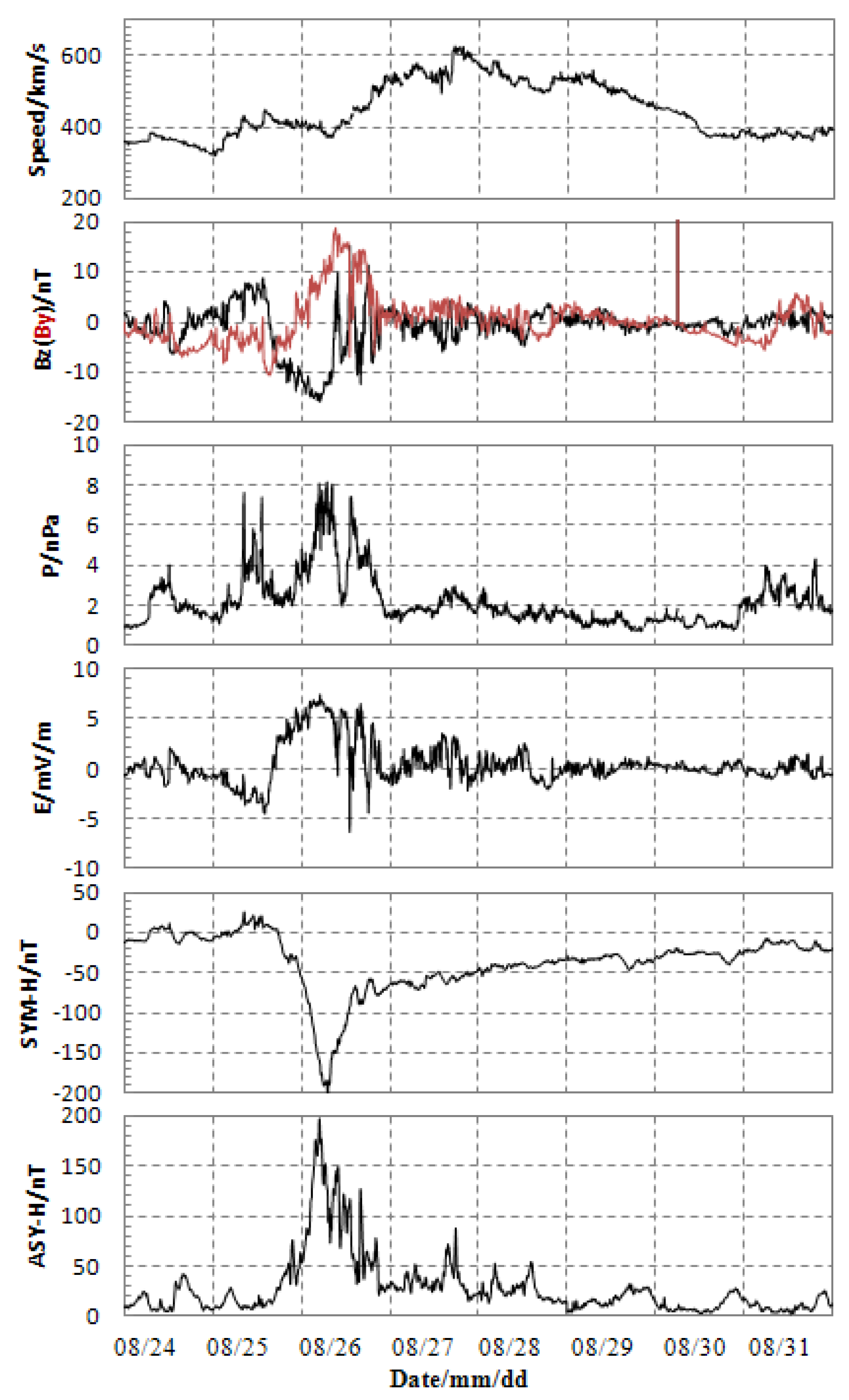

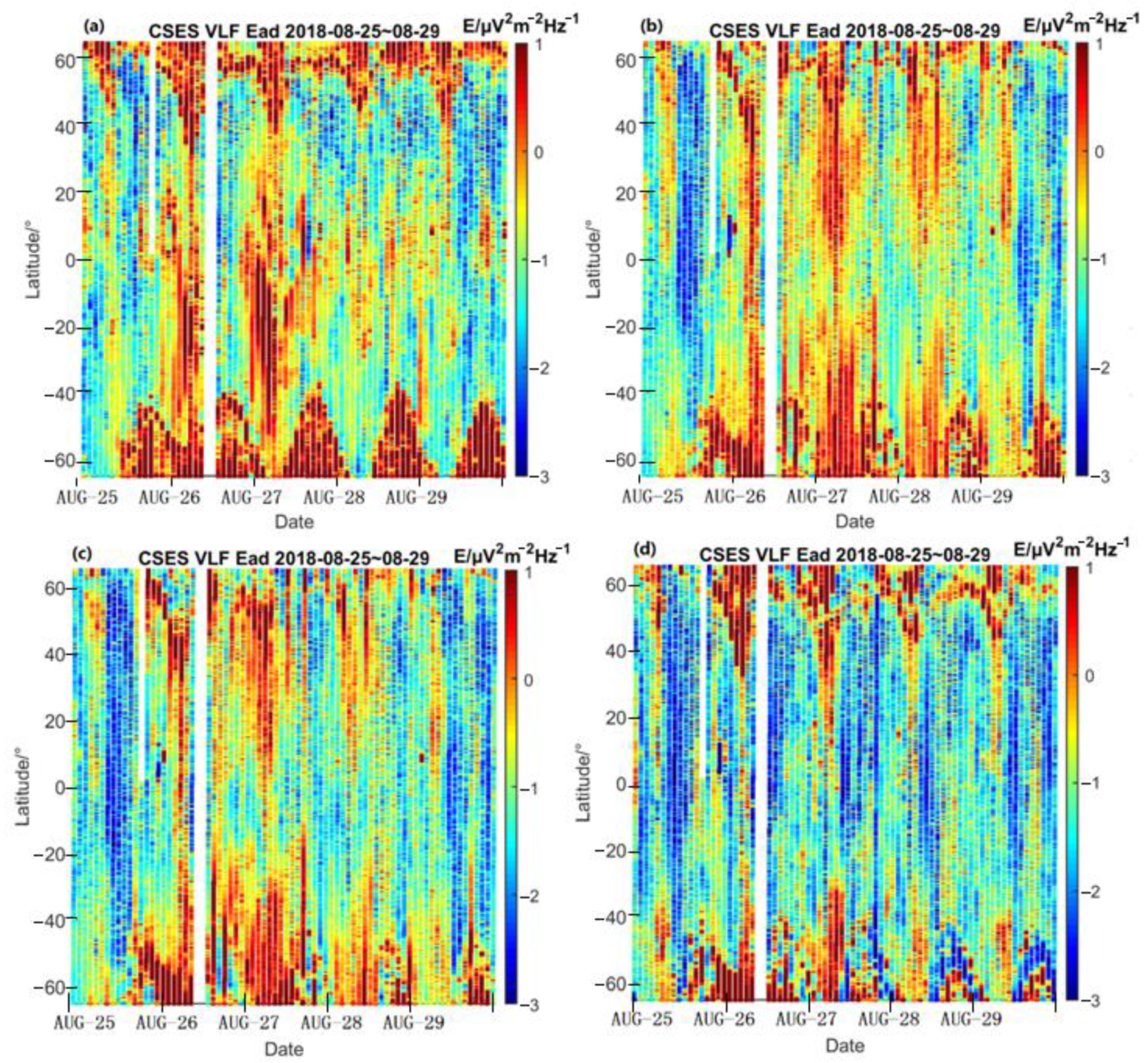
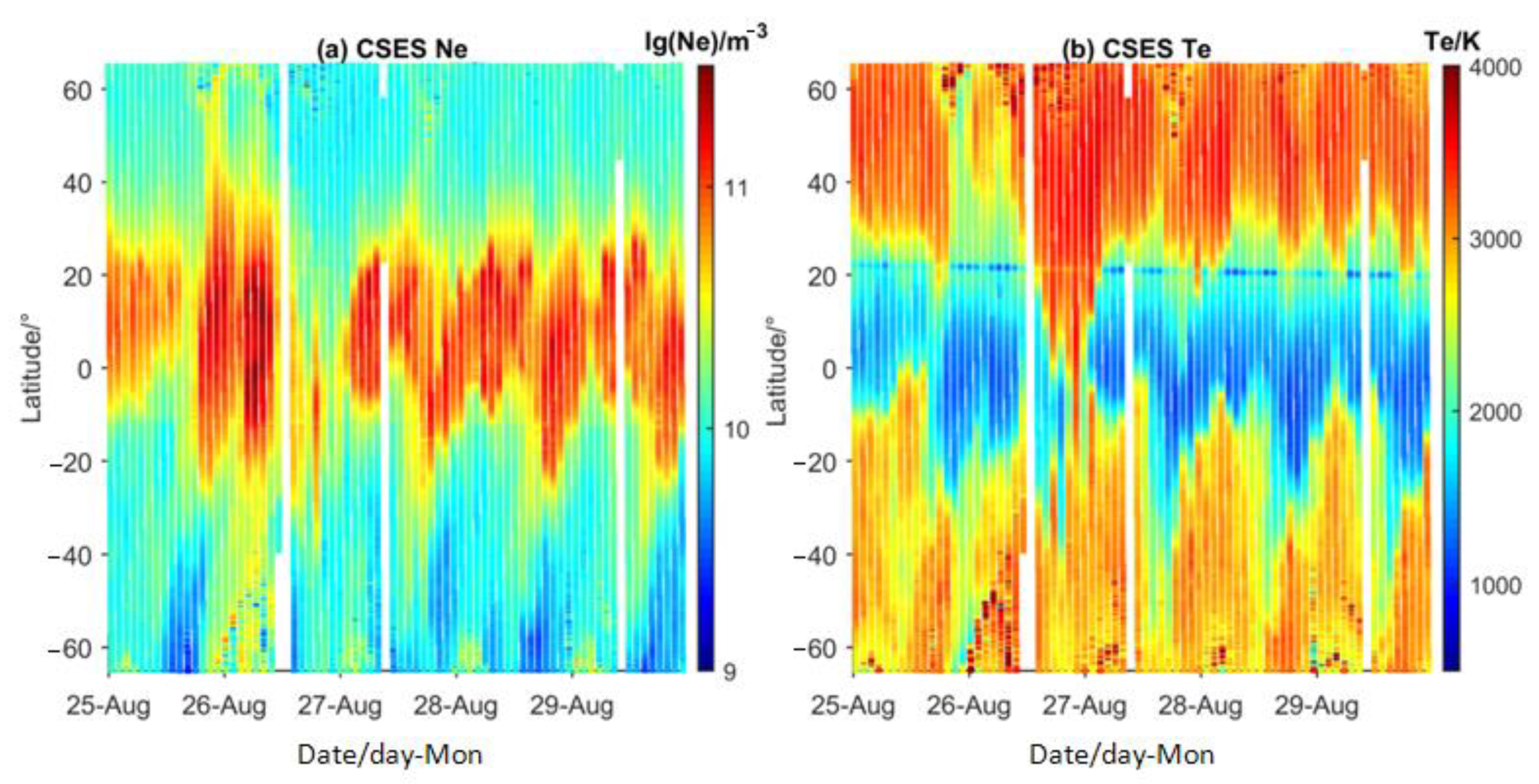
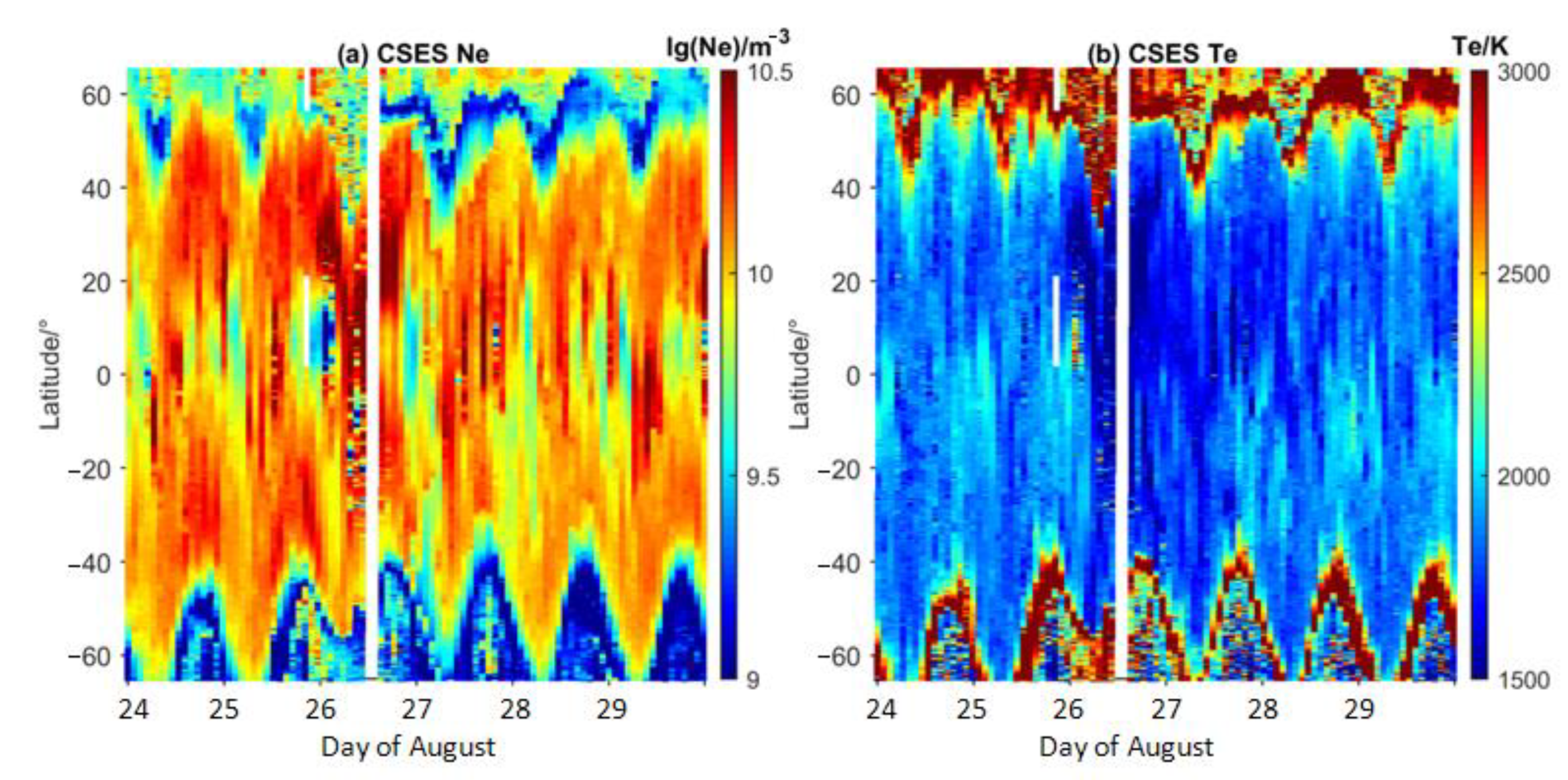
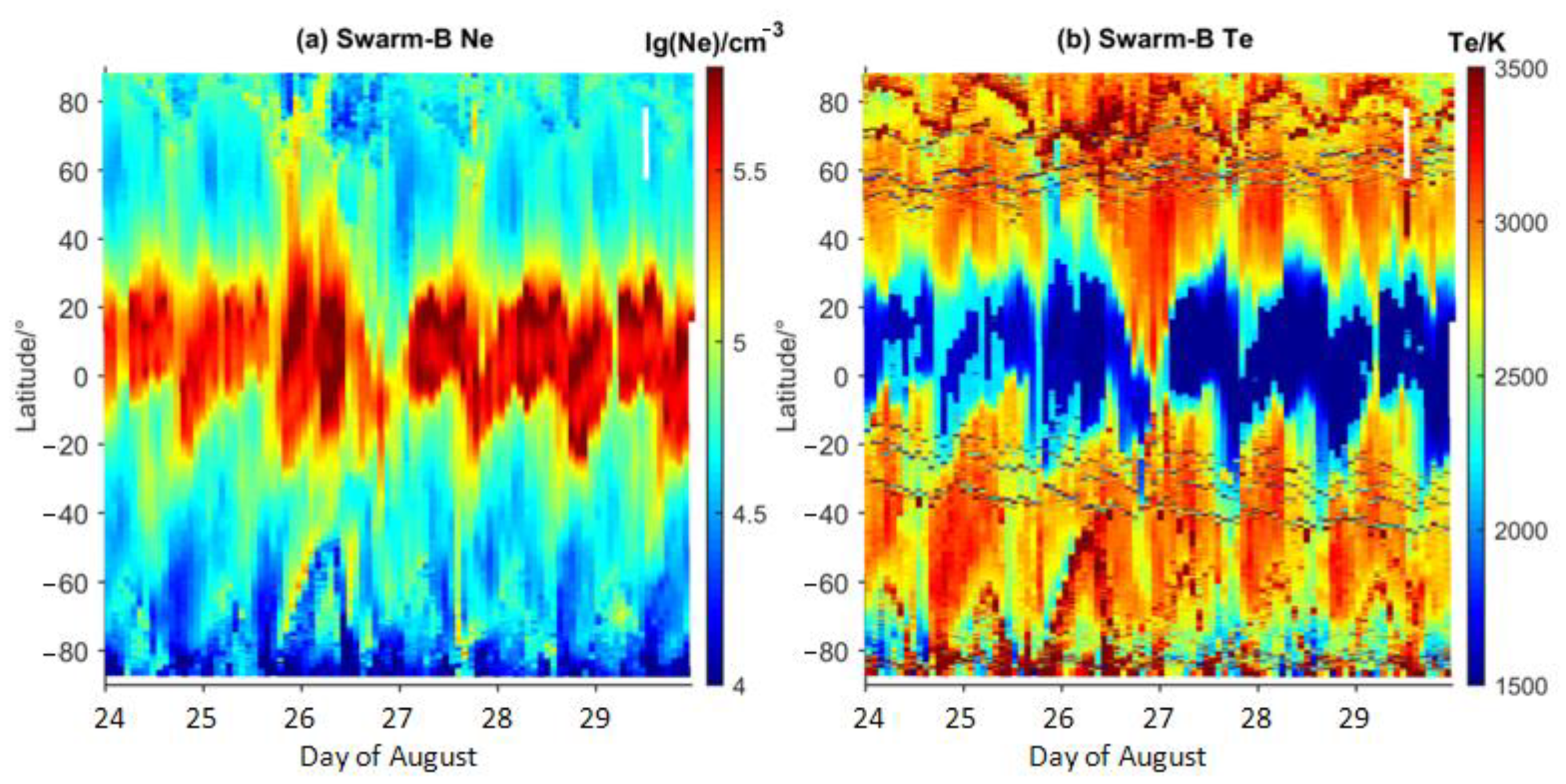

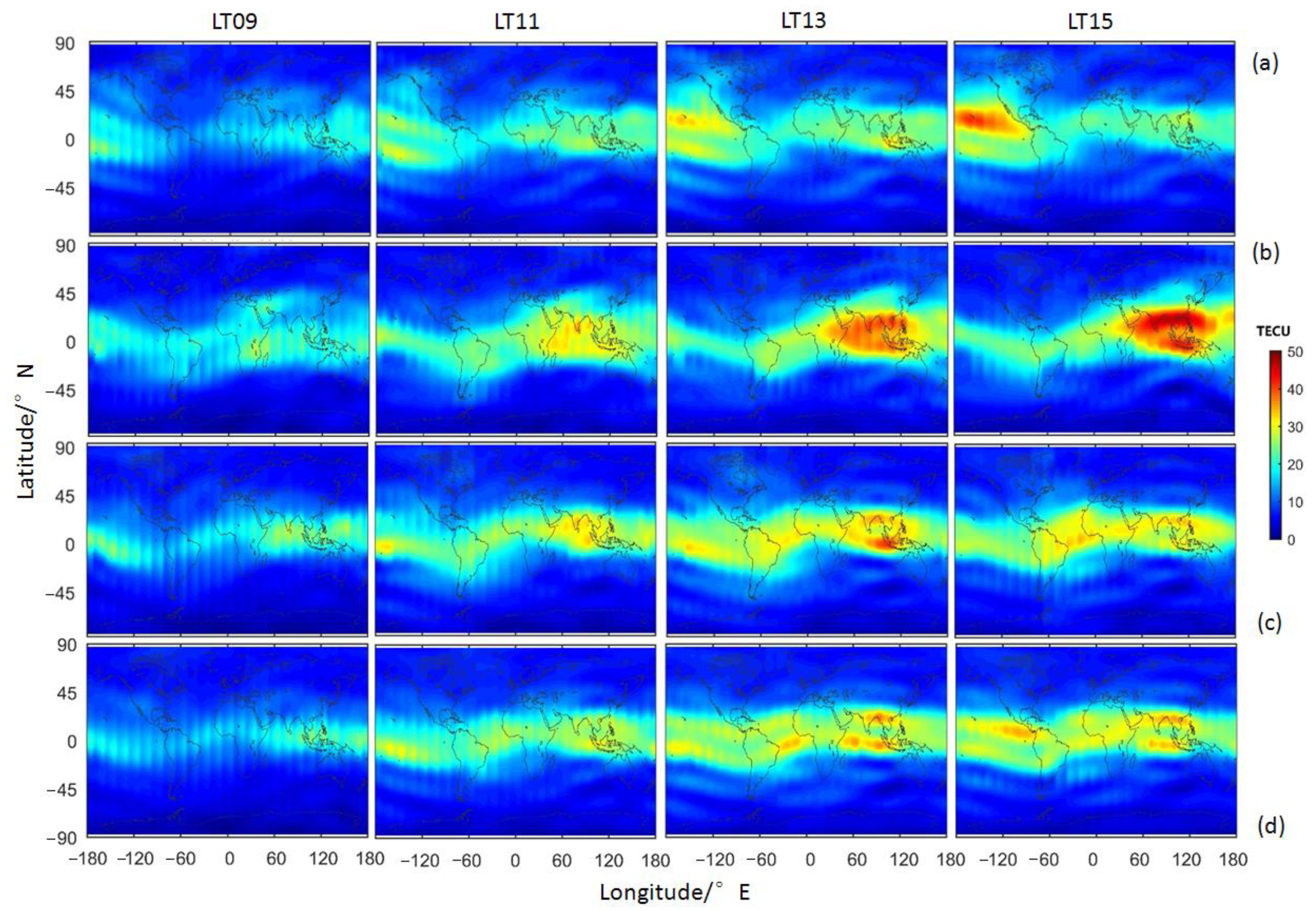
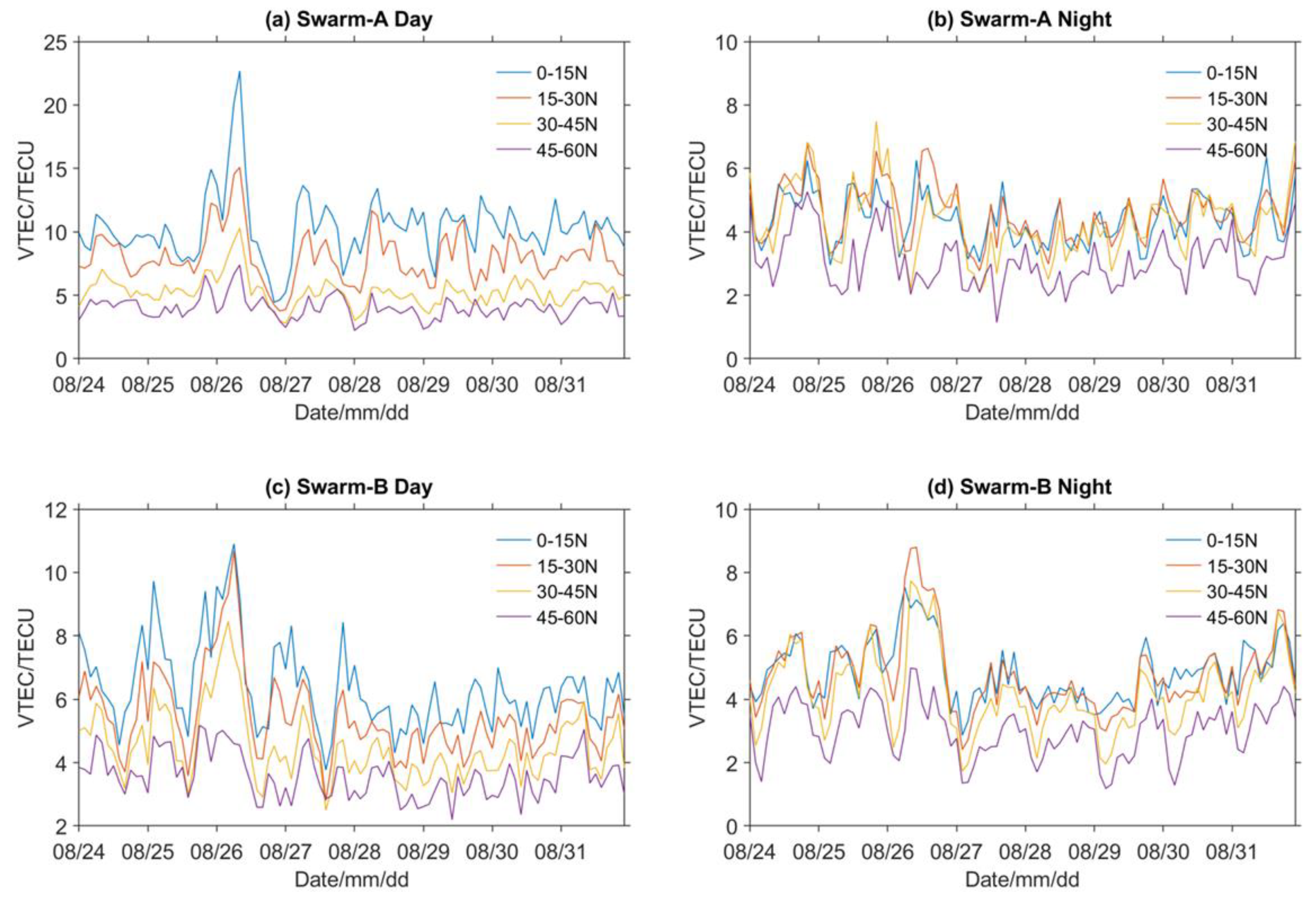

| Day of August | 24 | 25 | 26 | 27 | 28 | 29 |
|---|---|---|---|---|---|---|
| Latitude in northern hemisphere at UT 06–08/° N | 53.544 | 48.65 | 33.24 | 42.53 | 47.11 | 45.24 |
| Latitude in southern hemisphere at UT 06–09/° S | / | / | 55.60 | 64.11 | / | / |
| Latitude in northern hemisphere at UT 18–20/° N | 59.41 | 57.20 | 57.46 | 49.54 | 58.15 | 58.45 |
| Latitude in southern hemisphere at UT 18–20/° S | 49.80 | 46.04 | 40.71 | 41.60 | 41.66 | 42.83 |
| Latitudes | 45–60° S | 30–45° S | 15–30° S | 0–15° S | 0–15° N | 15–30° N | 30–45° N | 45–60° N |
|---|---|---|---|---|---|---|---|---|
| r of E/Ne in dayside on 26 August with E at 225 Hz | 0.040 | 0.78 | −0.42 | 0.83 | 0.91 | 0.93 | −0.24 | −0.32 |
| 725 Hz | −0.32 | 0.61 | −0.68 | 0.47 | 0.93 | 0.85 | −0.95 | −0.34 |
| 1125 Hz | −0.51 | 0.81 | −0.71 | 0.55 | 0.94 | 0.90 | −0.96 | −0.075 |
| r of E/Ne in dayside on 28 August with E at 225 Hz | 0.83 | 0.53 | 0.20 | 0.79 | 0.31 | −0.33 | −0.34 | −0.034 |
| 725 Hz | −0.27 | 0.18 | 0.60 | −0.88 | 0.30 | −0.58 | −0.65 | 0.36 |
| 1125 Hz | −0.54 | 0.088 | −0.31 | 0.15 | 0.56 | −0.26 | −0.70 | 0.43 |
| r of E/Ne in nightside on 26 August with E at 225 Hz | −0.59 | 0.17 | 0.61 | 0.43 | −0.044 | -0.51 | 0.057 | −0.65 |
| 725 Hz | −0.35 | 0.35 | 0.15 | 0.072 | −0.0089 | 0.40 | 0.27 | −0.61 |
| 1125 Hz | −0.48 | 0.64 | 0.13 | 0.42 | 0.049 | 0.036 | 0.20 | −0.59 |
| r of E/Ne in nightside on 28 August with E at 225 Hz | −0.50 | −0.034 | 0.015 | 0.52 | −0.33 | 0.064 | −0.069 | −0.59 |
| 725 Hz | −0.53 | 0.59 | 0.078 | 0.40 | 0.10 | −0.24 | 0.14 | −0.53 |
| 1125 Hz | −0.51 | 0.68 | 0.085 | 0.37 | 0.076 | −0.096 | −0.091 | −0.76 |
| Satellite LT Latitudes/° N | Swarm-A 14 LT 0–15 15–30 30–45 45–60 | Swarm-B 09 LT 0–15 15–30 30–45 45–60 | Swarm-A 02 LT 0–15 15–30 30–45 45–60 | Swarm-B 21 LT 0–15 15–30 30–45 45–60 |
|---|---|---|---|---|
| r of speed/TEC in 24–31 August | −0.10 −0.22 −0.35 −0.19 | −0.26 −0.27 −0.34 −0.33 | −0.37 −0.37 −0.430 −0.45 | −0.43 −0.40 −0.40 −0.41 |
| r of P/TEC in 24–31 August | 0.35 0.38 0.54 0.43 | 0.37 0.50 0.47 0.37 | 0.098 0.19 −0.040 −0.13 | 0.64 0.60 0.44 0.32 |
| r of speed/TEC in 27–31 August | −0.013 −0.104 −0.26 −0.054 | 0.026 −0.04 −0.20 −0.16 | −0.35 −0.40 −0.51 −0.42 | −0.51 −0.52 −0.53 −0.46 |
| r of P/TEC in 27–31 August | 0.096 0.11 0.16 0.20 | 0.088 0.22 0.28 0.35 | 0.033−0.019 −0.050 −0.064 | 0.32 0.37 0.32 0.29 |
Publisher’s Note: MDPI stays neutral with regard to jurisdictional claims in published maps and institutional affiliations. |
© 2022 by the authors. Licensee MDPI, Basel, Switzerland. This article is an open access article distributed under the terms and conditions of the Creative Commons Attribution (CC BY) license (https://creativecommons.org/licenses/by/4.0/).
Share and Cite
Zhang, X.; Dong, L.; Nie, L. The Ionospheric Responses from Satellite Observations within Middle Latitudes to the Strong Magnetic Storm on 25–26 August 2018. Atmosphere 2022, 13, 1271. https://doi.org/10.3390/atmos13081271
Zhang X, Dong L, Nie L. The Ionospheric Responses from Satellite Observations within Middle Latitudes to the Strong Magnetic Storm on 25–26 August 2018. Atmosphere. 2022; 13(8):1271. https://doi.org/10.3390/atmos13081271
Chicago/Turabian StyleZhang, Xuemin, Lei Dong, and Lei Nie. 2022. "The Ionospheric Responses from Satellite Observations within Middle Latitudes to the Strong Magnetic Storm on 25–26 August 2018" Atmosphere 13, no. 8: 1271. https://doi.org/10.3390/atmos13081271
APA StyleZhang, X., Dong, L., & Nie, L. (2022). The Ionospheric Responses from Satellite Observations within Middle Latitudes to the Strong Magnetic Storm on 25–26 August 2018. Atmosphere, 13(8), 1271. https://doi.org/10.3390/atmos13081271







